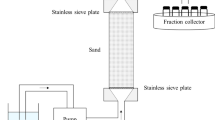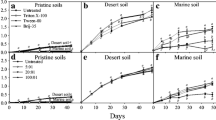Abstract
Pure mineral oil soils are removed from polyester substrates by the roll-up mechanism in nonionic surfactant systems, and the process is little affected by hardness ions or builder addition. For a given surfactant system, roll-up and removal efficiency increase with temperature until the cloud point of the nonionic is reached, whereafter a further increase in temperature decreases the rate of roll-up. In general, lower ethoxylated surfactants perform better than higher ethyxylates at low temperature, but the trend is gradually reversed as the temperature is increased. For a given degree of ethoxylation, secondary alcohol ethoxylates are more effective at rolling up mineral oil soils than their primary counterparts. Addition of a small amount of oleic acid to mineral oil soils facilitates the roll-up process (by lowering the oil/water interfacial tension) and minimizes the differences in performance among the various types of unbuilt nonionic surfactants. However, addition of highly alkaline electrolytic builders with these soils promotes oil removal by emulsification, presumably because of charge neutralization and/or transfer of the fatty acid into the aqueous phase. Conditions of high pH and low electrolyte strength inhibit the removal of 5.0% oleic acid in mineral oil soils, as exemplified by studies with added triethanolamine, ammonia, and very diluted NaOH. However, addition of divalent hardness ions to such systems promotes coarse emulsification of the soil, as does addition of relatively high concentrations of monovalent cation salts. A tentative explanation of this phenomenon is proposed. Ionic strength has little effect on the removal of 5.0% oleic acid/mineral oil soils below pH 7, as rapid roll-up is obtained regardless of added electrolytes. Similarly, ionic strength (or pH) has little effect on the removal of mineral oil containing polar, but nonionizing soils such as oleyl alcohol, as rapid rollup is achieved under a number of conditions.
Similar content being viewed by others
References
Adam, N.K., J. Soc. Dyers Color. 53: 121 (1937).
Young, T.A., Phil. Trans 84 (1805).
Lawrence A.S.C. Chem. Ind. 1764 (1961).
Stevenson, D.G., J. Soc. Cosmet. Chem. 12: 353 (1961).
Scott, B.A., J. Appl. Chem. 13: 133 (1963).
Hartley, G.S. J. Chem. Soc. 1968 (1938).
Dervichian, D.G., Proc. 2nd Int. Cong. Surface Activity 1: 327 (1957).
McBain, J.W., “Advances in Colloid Science,” Interscience, New York, p. 99.
Schwartz, A.M., Surf. and Colloid Sci. 5: 211 (1972).
Hartley, G.S., “Wetting and Detergency,” Harvey, London, 1937 p. 153.
Lawrence, A.S.C., Trans. Faraday Soc. 33: 315 (1937).
Durham, K., “Surface Activity and Detergency,” MacMillan, London 1961 p. 131.
Ogino, K., M. Abe, N. Takesita, Bull. Chem. Soc. Japan 49: 3679 (1976).
Kolthoff, W.D., I.M. Stricks, J. Phys. Colloid Chem., 52: 915 (1948).
Riegleman, S., N.A. Allawala, M. Hrenoff, L.A. Strait, J. Colloid Sci. 13: 208 (1954).
Durham, K., “Surface Activity and Detergency,” p. 150.
Griffin, W.C., J. Soc. Cosmetic Chem. 1: 311 (1949).
Griffin, W.C., J. Soc. Cosmetic Chem. 5: 1 (1954).
Davies, J.T., E.K. Eideal, “Interfacial Phenomena,” 2nd ed., Academic Press, New York, 1963, p. 371.
“Emulsion Science”, Edited by P. Sherman, Academic Press, New York, 1968, p. 1.
Schwartz, A.M., J.W. Perry, J. Berch, “Surface Active Agents and Detergents,” Interscience, New York, 1958, p. 467.
Powney, J., J. Text. Inst. Trans. 40: 549 (1949).
Stevenson, D.G., J. Text. Inst. Trans. 42: 194 (1953).
Durham, K., “Surface Activity and Detergency,” p. 146.
Stevenson, D.G., J. Textile Inst. 44: T12 (1953).
“Solvent Properties of Surfactant Solutions”, Edited by K. Shinoda, Marcel Dekker, New York, 1967, p. 27.
Fort, T., Billica, H.R., Grindstaff, T.H. Text. Res. J. 36: 99 (1966).
McGuire, S.E., T.P. Matson, JAOCS 52: 411 (1975).
Schonfeldt, N., “Surface Active Ethylene Oxide Adducts,” Pergamon Press, 1969 pp. 388–435.
Smith, S., B. Johannessen, P.O. Sherman, Text. Chem. Color. 5: 138 (1973).
Kling, W., E. Lange, I. Haussner, Milliand Textilber, 25: 198 (1945).
Stewart, J.C. C.S. Whewell, Text. Res. J. 30: 903 (1960).
Ogino, K., A. Wataru, Bull. Chem. Soc. Japan 49: 1703 (1976).
Ogino, K., K. Shigemura, Bull. Chem. Soc. Japan 49: 3236 (1976).
Harris, J.C., W.H. Yanko, Am. Soc. Test. Mater. Bull. 49: 158 (1949).
Gordon, B.E., JAOCS 45: 367 (1968).
Gordon, B.E., W.T. Shebs, R.U. Bonnar, JAOCS 44: 711 (1967).
Gordon, B.E., J. Roddewig, W.T. Shebs, JAOCS 44: 289 (1967).
Fort, T., H.R. Billica, C.K. Sloan, Text. Res. 1: 7 (1966).
Bowers, R.C., W.C. Clinton, W.A. Zisman, Lubr. Eng. 9: 204 (1953).
Schwartz, A.M., Surf. Colloid Sci. 5: 211 (1972).
Durham, K., “Surface Activity and Detergency,” pp. 76–77.
U.S. Patent No. 3,983,078.
Durham K., “Surface Activity and Detergency,” pp. 20–25.
Saito, H., K. Shinoda, J. Colloid Interface Sci. 24: 10 (1967).
Speakman, J.B., and N.H. Chamberlain, Trans. Faraday Soc. 29: 358 (1933).
Durham, K., “Surface Activity and Detergency,” p. 93.
Vitale, P.T., J. Ross, and A.M. Schwartz, JAOCS 32: 200 (1955).
Sanders, H.L., J.M. Lambert, Text. Res. J. 21: 680 (1951).
Vaughn, T.H., H.R. Sater, M.G. Kramer, “Ind. Eng. Chem.”, 46: 1934 (1954).
Adamson, A.W., “Physical Chemistry of Surfaces,” 2nd Ed., Interscience, New York, p. 490.
Mansfield, W.W., “Aust. J. Appl. Sci.” 3: 193 (1952).
Author information
Authors and Affiliations
About this article
Cite this article
Dillan, K.W., Goddard, E.D. & McKenzie, D.A. Oily soil removal from a polyester substrate by aqueous nonionic surfactant systems. J Am Oil Chem Soc 56, 59–70 (1979). https://doi.org/10.1007/BF02671763
Received:
Issue Date:
DOI: https://doi.org/10.1007/BF02671763




